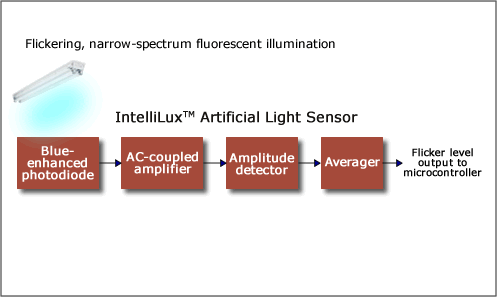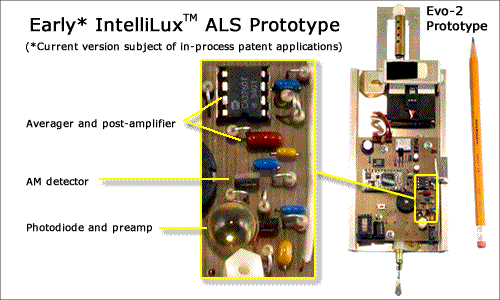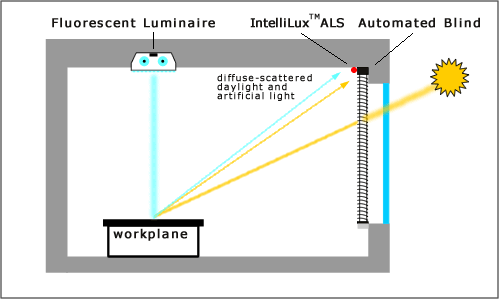IntelliLux™ Artificial Light Sensor (ALS) Technology
Overview
The IntelliLux™ Artificial Light Sensor (ALS) senses the light produced by AC-powered lighting systems—including those using incandescent, magnetically ballasted fluorescent, electronically ballasted fluorescent, and LED-based lamps—while ignoring daylight. It was developed to enable automated shading systems to reliably "know" the on/off state and relative brightness of lighting systems in daylit rooms.
One way to think of the IntelliLux™ ALS is as the indoor equivalent of the dusk/dawn sensors included in many conventional automated shading products. Dusk/dawn sensors are useful for automated shading because people typically prefer different shading settings in daytime and nighttime.
However, the state of the room lights is just as important as the dusk/dawn state in determining the desired shading setting. For example, automated shading products with dusk/dawn sensors are often programmed to close at dusk and open at dawn. But what most users really want is for the shading to close at dusk only when the lights are on, and to open at dawn only when the lights are off. The IntelliLux™ ALS gives an automated shading system the lighting-state information it needs to do this.
The on/off state of the room lights is also a crucial piece of information for Dynamic Daylight Control (DDC) systems used in daylighting applications. While DDC is the key to exploiting daylighting's full energy saving potential, it's only needed during the daytime when the lighting system is on. When the lighting system is off, energy savings are maximized if DDC is suspended and the shading is either fully closed (in cooling-dominated buildings) or fully opened (in heating-dominated buildings) to minimize loads on the HVAC system. Again, the IntelliLux™ ALS gives the DDC system the lighting-state information it needs to do this.
The best way for an automated shading system to exploit the lighting state information provided by the IntelliLux™ ALS—along with any available environmental information from other sensors—is the via the patent-pending IntelliState™ Automation algorithm. However, the IntelliLux™ ALS can make any automated shading product "smarter"—with or without IntelliState™.
How it Works
Virtually all lighting systems used in today's buildings produce flickering illumination. With incandescent lamps (and fluorescent lamps operated by magnetic ballasts), the flicker occurs at twice the AC line frequency, or 120 times per second in the USA. Because incandescent lamps generate light by heating a filament, the flicker produced by such lamps isn't obvious to the human eye: due to the thermal mass of the filament, there isn't enough time for the filament temperature to vary much between "flickers". With fluorescent lamps operated by magnetic ballasts, however, the flicker is fairly perceptible (and often annoying).
On the other hand, with fluorescent lamps operated by electronic ballasts, and with LED lighting systems operated by switching power supplies, the flicker occurs at a much higher frequency—up to and sometimes greater than several tens of kiloHertz. This is too fast to be sensed by the human eye, which is one major advantage (beyond increased efficiency) of these more modern lamp technologies.

The IntelliLux™ ALS detects this flicker—whether produced by incandescent, fluorescent, or LED lamps, and regardless of its frequency—to reliably sense the presence and relative brightness of artificial illumination.
Advantages
Simple, Inexpensive Design
While the flicker in artificial illumination is often completely imperceptible to humans, it's very easy to detect with electronics. A variety of IntelliLux™ ALS implementations are possible, each offering a different balance of cost and performance. The following chart shows a block diagram of the high-performance IntelliLux™ ALS implementation used in the current version of the IntelliBlinds™ Model D miniblind actuator:

As the chart shows, this particular version of the IntelliLux™ ALS produces an analog signal, proportional to the level of flickering illumination, that can be read by any microcontroller that has an A/D port. Despite providing information concerning both the on/off state and the relative brightness of the lighting system, it requires only a handful of inexpensive components, and takes up very little space on a circuit board.

In production quantities, the components of this high-performance IntelliLux™ ALS implementation cost about $1.20, adding only about $5.00 to the retail price of an automated shading product (including labor and industry standard mark-ups). And if only the on/off state of the lighting system is needed—and not the relative brightness—the cost can be reduced still futher.
Can Be Integrated Into Shading Device
One key advantage of the IntelliLux™ ALS is that it doesn't have to be located or aimed in any particular way relative to the source of artificial illumination: as long as there's artificial illumination in the room and some of it can reach the photodiode, the IntelliLux™ ALS will reliably detect it. This makes it very easy to integrate into shading products: all that's needed is a few tenths of a square inch on a circuit board and a light path to the photodiode.
That's a major advantage for use with automated shading systems based on motorized blinds or shades, because it means that the IntelliLux™ ALS can be co-located with the rest of the electronics at the top of the window. And that, in turn, enables a fully self contained system—significantly reducing system cost, and complexity.

The savings due to co-location with the rest of the electronics are substantial: a wired link between the shading system and a remote sensor (or the lighting system itself) has an average installed cost of $20, while the IntelliLux™ ALS adds just $5 to the retail price of the system (including typical mark-ups). And the savings are even greater when considering the avoided cost of a remote sensor or modifications to the lighting system.
Simple Set-Up
In a typical application, all that's necessary to set-up a system that incorporates the IntelliLux™ ALS is to "teach" it the maximum and minimum brightness levels produced by the lighting system. Because the IntelliLux™ ALS is insensitive to daylight, this can be done in daytime or nighttime.
And, in systems that only need the on/off state (and not the relative brightness) of the lights, the IntelliLux™ ALS can be set at the factory so that it's ready to go "out of the box", with no set-up whatsoever.
Intellectual Property Protection
The IntelliLux™ ALS is protected by U.S. utility patent 5,598,000, with an additional patent applied for.
Summary of Key Points
- The IntelliLux™ Artificial Light Sensor (ALS) senses the light produced by AC-powered lighting systems—including those using incandescent, magnetically ballasted fluorescent, electronically ballasted fluorescent, and LED-based lamps—while ignoring daylight.
- The IntelliLux™ ALS was developed to enable automated shading systems to reliably "know" the on/off state and relative brightness of lighting systems in daylit rooms; such information is important, for example, for Dynamic Daylight Control in daylighting applications
- The IntelliLux™ ALS works by taking advantage of the fact artificial light has a flickering characteristic (which can be detected with simple electronics), while daylight doesn't
- The IntelliLux™ ALS offers a number of important advantages:
- It's inexpensive, adding less than $5 to the retail cost of automated shading
- It can be integrated with the rest of the electronics of a headrail-mounted automated shading system, eliminating the need for remote sensors or wiring, saving at least $15 (and typically much more)
- It's trivially easy to calibrate during system set-up, and in many applications requires no calibration at all

